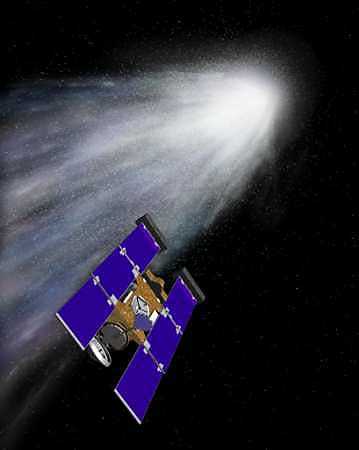Better All The Time #28

| ||
|
Welcome to the first edition of Better All the Time for 2006. Our somewhat belated new year's resolution is to bring you more good news than ever before. So beginning with this edition, we will be featuring 12 -- that's right, 12! -- good news stories with each and every edition. So let's get started!
The most beautiful thing we can experience is the mysterious. It is the source of all true art and science.
- - - - -
Item 1
Black
Currants to Thwart Alzheimer's
Compounds in black currants may help protect against Alzheimer's disease, according to a study in the current issue of Chemistry & Industry magazine.
Researchers found that these compounds -- anthocyanins and polyphenolics -- had a strong protective effect in cultured neuronal cells. Darker black currants contain more anthocyanins and are likely to be more potent.
The good news:
Black currants have already been shown to be powerful antioxidants. This new evidence indicates that they have a direct beneficial effect on the brain.
Additional resources:
Here's a list that might prove helpful for those looking to take advantage of both the antioxidant and brain protecting qualities of black currants.
- - - - -
Item 2
How to do what you love
Essayist Paul Graham outlines a path for finding work that you love to do and, well, doing it:
To do something well you have to like it. That idea is not exactly novel. We've got it down to four words: "Do what you love." But it's not enough just to tell people that. Doing what you love is complicated.
The very idea is foreign to what most of us learn as kids. When I was a kid, it seemed as if work and fun were opposites by definition. Life had two states: some of the time adults were making you do things, and that was called work; the rest of the time you could do what you wanted, and that was called playing. Occasionally the things adults made you do were fun, just as, occasionally, playing wasn't-- for example, if you fell and hurt yourself. But except for these few anomalous cases, work was pretty much defined as not-fun.
Graham believes that it's long past time those boundaries were re-drawn, and he outlines a plan for doing exactly that. Along the way, he makes a number of shocking proposals, such as:
I'm not saying we should let little kids do whatever they want. They may have to be made to work on certain things. But if we make kids work on dull stuff, it might be wise to tell them that tediousness is not the defining quality of work, and indeed that the reason they have to work on dull stuff now is so they can work on more interesting stuff later.
He raises important questions, such as:
Why is it conventional to pretend to like what you do? The first sentence of this essay explains that. If you have to like something to do it well, then the most successful people will all like what they do.
Ans he provides a number of wonderful insights, such as:
Prestige is just fossilized inspiration. If you do anything well enough, you'll make it prestigious. Plenty of things we now consider prestigious were anything but at first. Jazz comes to mind-- though almost any established art form would do. So just do what you like, and let prestige take care of itself.
All told, the essay is a great read -- highly recommended for those who might not be as completely satisfied with what they do as they would like to be.

- - - - -
Item 3
Leopards
Mate Successfully
 Our
first of three animal-related good news stories is a touching demonstration
of love conquering all:
Our
first of three animal-related good news stories is a touching demonstration
of love conquering all:
...Zoe, who lives at the Smithsonian National Zoo's Conservation and Research Center in Front Royal, Virginia, is no kitty cat; she's a rare clouded leopard. And the specialists at the center are among the few animal experts in the world who have been able to get clouded leopards to breed without literally killing one another.
Since the zoo started its captive breeding program in 1978, 75 clouded leopard cubs have been born.
The Good News:
For years the incredibly rare cats had frustrated zookeepers hoping to breed them. The males killed the females, sometimes almost instantly. Even if they could tolerate one another in a cage, they refused to breed.
The zookeepers at the Smithsonian worked tirelessly to remedy that untenable situation, tweaking both the environment and the diet of the leopards to make them more compatible. Keeping the leopards well clear of other big cats, especially tigers, made the males more relaxed and less likely to attack. Socializing the cats with people also had a surprisingly beneficial effect.
Objections?
Some would argue (no doubt correctly) that it is captivity itself that makes it so difficult for the clouded leopards to breed. If they were set free, rather than kept in a zoo, the problem would disappear. That's an appealing argument, but it flies in the face of a sad reality:
Fewer than 10,000 clouded leopards are believed to survive in the wild. The breeding program may hold the key to the future of a species vanishing fast as its forest homes disappear and as poachers learn how to capture them.
We should look for a day when clouded leopards can live safely in a natural environment. But until that day comes, here's hoping that Smithsonian Zoo continues to find ways to keep them going.
- - - - -
Item 4
Funny
People Are Attractive
 While
we're on the subject of love, here's some an interesting development:
While
we're on the subject of love, here's some an interesting development:
If love is blind, then maybe humour is the attention-grabber.
That's the conclusion of two recent studies that confirm a long-standing stereotype of flirting: that women like joky men, while men like women who laugh at their jokes.
Good News:
The good news here for anyone looking to get into (or sustain) a relationship is pretty straightforward: a little humor (or appreciation thereof) goes a long way.
Recommended reading:
- - - - -
Item 5
50
Inventions
Popular Mechanics has a round-up of the 50 most important inventions of the past 50 years. Here are the top picks from the years 1955-1960:
1955--TV REMOTE CONTROL
1955--MICROWAVE OVEN
1957--BIRTH-CONTROL PILL
1958--JET AIRLINER
1959--FLOAT GLASS
Good News:
Inventions such as these do good both for the world and for the inventors. Each of the inventions chosen for the article did more than improve our lives. Each became profitable in its own right, and gave rise to other profitable products and services as well.
Bonus:
While you're visiting the Popular Mechanics web site, be sure to check out the thorough debunking of the bogus piece the magazine has recently been reported to have run in 1954 on the subject of the Home Computer of the Future.
A Quibble:
The Popular Mechanics article dates the introduction of the home computer to 1977 and the Apple / Commodore / Tandy models of the era. At the Speculist, we much prefer the mid-century modern elegance of the Honeywell 316 "Kitchen Computer" sold in the 1969 Neiman-Marcus Catalog ($10,000, equivalent to $53,215.26 in 2005) and date accordingly.

- - - - -
Item 6
Penguin
Parents Lay New Egg
The second of our animal good news stories also has to do with captive animals reproducing. This story is a happy follow-up to a very unfortunate turn of events that unfolded right around the end of last year:
The parents of a baby penguin, whose theft from a zoo just before Christmas attracted worldwide attention, have produced a new egg.
Toga, a three-month-old Jackass penguin, was snatched from Amazon World zoo on the Isle of Wight, off the south coast of England, after thieves broke in one night last month.
Pictures of his crestfallen parents Kyala and Oscar made the front page of many newspapers while donations and messages of support flooded in from all over the world.
Despite a number of reported sightings, Toga, who could only survive a matter of days without his parents, was never found.
"There's some good news at last," zoo manager Kath Bright told Reuters on Monday after staff discovered Kyala and Oscar were expecting their second offspring.
Here's hoping...
For a successful hatching and that the staff of the Amazon World Zoo have remedied their security problems.
- - - - -
 It
turns out that corn is more than just a good source of food fiber and vitamin
A :
It
turns out that corn is more than just a good source of food fiber and vitamin
A :
Corn is the new king when it comes to heating stoves.
It appears that every manufacturer of corn-fueled stoves in the United States and Canada is facing a backlog of orders because of the huge demand. Both manufacturers and dealers seem to have been caught by surprise by the wave of consumer interest.
Why all the sudden hullabaloo? Simple – nothing costs less to burn at this point than corn, which sells for about $2 per bushel. According to figures provided by Even Temp, maker of the St. Croix line of stoves, the cost per therm for 100,000 British thermal units is 42 cents. The same per therm cost for natural gas is $1.40 and $2.60 for propane (LP). Wood is 64 cents per therm.
Good News:
This information is confirmed (in the short-run case) by this from the University of Minnesota and, while there is room in the accounting and thermodynamic calculations for adjustment to take into account other, indirect, costs (for instance, costs associated with transportation, storage, and distribution of proposed alternatives) and 'subsidies' applicable to 'conventional' and 'alternative' fuels (for instance, military and diplomatic costs of obtaining fuels from overseas suppliers vs. costs of energy and chemical inputs to 'modern' agriculture that may, or may not, accurately reflect their true long-term cost), the fact remains that at this time and within the current economic and legal frameworks shelled corn enjoys considerable advantage (over 3x !) over the next least costly 'conventional' fuel.
Even Better News:
This development provides yet another market for a crop grown within the United States, tending both to support bottom end of the commodity price, which is good for farmers, and tends to make economic subsidies less attractive, which is good for taxpayers. Finally, an additional source of less-costly energy, under secure control within the U.S., tends to reduce the motivation to secure resources overseas.
Addressing Likely Objections:
Of course, it isn't possible to completely replace imported, or even domestically produced, fossil fuels with this sort of 'biomass' energy, but it replaces a fraction and thus improves the situation. Likewise, using corn for fuel in the US won't contribute to worldwide food shortages in an appreciable way. The largest current applications of zea mays in the North American market are as animal feed and the making of sweeteners [High Fructose Corn Syrup], neither of which contribute directly to subsistence. Even if the relatively small fraction of the crop that will be diverted to heating from all other uses could be, instead, given to those, domestically and overseas, that would benefit most from the additional food, transportation costs for the bulk grain would outweigh much of the benefit and all parties would gain more if the cash equivalent could be transferred instead.
Related Late-Breaking News:
In the January 27th, 2006 issue of Science, researchers from U.C. Berkeley reveal that ethanol from corn and other biomass may be the economical way to leverage existing stores of fossil petroleum to provide transportation fuel in the future (see an overview of the research at LiveScience, the abstract, featuring the money quote "Farrell et al. (p. 506) rigorously analyzed a variety of relevant investigations, and found that the studies reporting negative net energy values are flawed," at Science and the researchers' website, for additional information. We certainly will.)
- - - - -
Item 8
Broadband
Brings Jobs
A new study by researchers at Carnegie Mellon and MIT provides strong empirical evidence for the claim that broadband Internet access drives economic growth. The report looks at data from 1998 through the end of 2002 and finds that there is a strong correlation between residential and small business broadband access (cable, DSL, and satellite) in any particular ZIP code and that area's job growth, IT growth, and rise in rates for rental housing (which are used as a proxy for property values).
Good News:
As we noted in Item 5, above, positive developments often seem to beget more positive developments. The final entry in the list of the Top 50 inventions indicates that broadband access may soon be easier to establish than a cellular network. Bring it on!

- - - - -
Item 9
Robot
Pets Provide Health Benefits
Our third and final bit of animal-relate good news:
Sure, pets are cute and seem to improve human health. But there are some places where they can't live, such as nursing homes. So can a robot pet provoke the same reactions?
Yes, according to a few preliminary studies -- but not to the same degree.
 The good news:
The good news:
We're in the early days of robot pets. Future generations will not only provide more of the same emotional benefits that real pets provide, they will be able to perform many of the functions that service animals currently perform. A few generations beyond that, they'll be able to do even more -- like maybe carry on conversations with their owners.
A setback?
As of its latest quarterly-earnings announcement, Sony has stated its intention to no longer manufacture their Aibo robot dog. No doubt others will pick up where Sony is leaving off.
- - - - -
Item 10
DNA Database
Growing Exponentially
FuturePundit Randall Parker writes:
One reason why I am optimistic that rejuvenation therapies using Strategies for Engineered Negligible Senescence can reverse the aging process within the lifetimes of most people reading this is that the rate of advance of biotechnology is increasing resembling the rate of advance of electronic technology. The rate of accumulation of DNA sequence information in a public database is doubling every 10 months.
The Archive is 22 Terabytes in size and doubling every ten months - perhaps the largest single scientific database in Europe, if not the world.
The database is large even compared to major non-DNA computer databases.
Martin Widlake, Database Services Manager at the Wellcome Trust Sanger Institute said: "At 22 000 GB the Trace Archive is in the Top Ten UNIX databases in the world. That's not bad for a research organisation of 850 employees in the countryside just outside Cambridge."
"It is possibly the biggest single (acknowledged) scientific RDBMS database in Europe, if not the world."
All the data are freely available to the world scientific community (http://trace.ensembl.org/), as a resource to geneticists all over the globe. When a researcher is studying a disease or gene, they can download the genetic information known about the area they are studying.
A question:
Will exponential growth in our knowledge of human DNA lead to exponential growth in the health benefits we derive from this knowledge?
Stranger things have happened.
- - - - -
Item 11
Stardust Comes Home
Fresh from its fall to Earth last weekend, the Stardust sample return capsule has been opened in a cleanroom at NASA's Johnson Space Center in Houston.
It exceeds all expectations, said Donald Brownlee, Stardust's lead scientist from the University of Washington. Its a huge success, he said in a university statement released Wednesday.
Good News:
Brownlee reports that the capsule may contain as many as a million specs of space dust. That's a million data points about our solar system that we didn't have before. Our knowledge of our local neighborhood in space may be about to experience a growth surge similar to what's happening with our DNA knowledge.

- - - - -
Item 12
Star
Trek Watch: Disruptions in the Space-Time Continuum
A spinning black hole in the constellation Scorpius has created a stable dent in the fabric of spacetime, scientists say.
The dent is the sort of thing predicted by Albert Einstein's theory of general relativity. It affects the movement of matter falling into the black hole
The good news:
As many of you know, we at Better All The Time are dedicated to tracking and reporting developments that show how our world is merging with the world of Star Trek.
Apparently the sensors that were used to detect these disruptions have been subjected to a Level 1 Diagnostic and tested at a distance. We should now be able to detect any negative spacetime curvature, natural or artificial. Those who know…know.

- - - - -
Better All The Time is compiled by Phil Bowermaster, Stephen Gordon, and Michael Sargent. For more news on how our world is rapidly changing and improving, check out the latest FastForward Radio and the Carnival of Tomorrow.
Live to see it!
Comments
Regarding Item #1, there's other research also going on regarding black currants. In this case, the component of interest is a MAO inhibitor.
Posted by: triticale![[TypeKey Profile Page]](http://www.blog.speculist.com/nav-commenters.gif) |
January 29, 2006 03:26 PM
|
January 29, 2006 03:26 PM